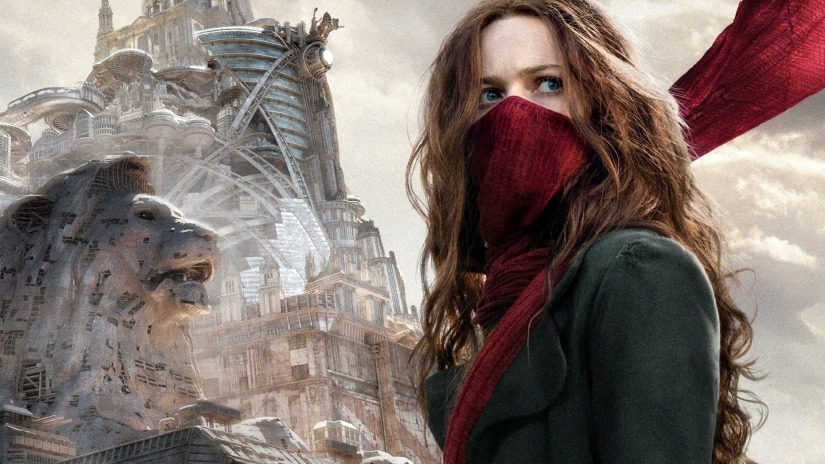For a story that revolves around giant motorised cities, flying airships and steampunk cyborgs, Mortal Engines is puzzlingly forgettable.
The latest project from Lord Of The Rings director Peter Jackson, Mortal Engines has had a troubled genesis. Adapted from a somewhat unknown young adult novel by Philip Reeve, the film has been in development for almost a decade, after Jackson had to shelve the project for five years while working on The Hobbit and its sequels.
The premise is an engaging one: in the future, a catastrophic war has forced settlements to uproot themselves and become mobile, strapping engines and wheels to themselves in order to hunt for resources. Larger cities eat smaller ones, in a system known as “municipal Darwinism”.
The central axis of the story is London – or a version of it, at least. The city is home to Tom Natsworthy (Robert Sheehan), an ordinary historian who finds himself thrust into adventure after foiling the assassination of his hero Thaddeus Valentine (Hugo Weaving) by Hester Shaw (Hela Hilmar) – a dangerous, disfigured girl with a mysterious past.
Tom and Hester find themselves thrown out of London and abandoned in the wasteland, forcing them to work together for survival despite their mutual dislike for one another. Both want to track down the city – Tom so he can get back home, and Hester so she can complete her objective and kill Valentine.
It’s easy to see why Jackson was attracted to the property – the book is full of vivid descriptions of vast steampunk metropolises chugging through the wasteland in search of prey, like some bizarre hybrid of Sim City and Mad Max, as our characters travel through fantastical locations like the imposing shield wall of Shan Guo or the floating city of Airhaven.
However, while Jackson is the driving force behind the film, he’s not directing it. Instead, he’s acting as producer and screenwriter, reteaming with long-time co-writers Fran Walsh and Philippa Boyens. In the director’s chair is another Middle-earth alum, Christian Rivers. Although he’s worked on all of Jackson’s Tolkien adaptations as part of Jackson’s visual effects studio Weta Digital, this is Rivers’ first time as director.
Rivers’ background in VFX really shines here. The film looks absolutely gorgeous. It should come as no surprise that the team behind the Tolkien adaptations are good at making visually spectacular films, but Mortal Engines’ post-apocalyptic world is brimming with personality, too. The cities we see – both the mobile “traction cities” and static settlements – all have their own unique look and feel, while also giving the sense of being real and lived-in.
London, in particular, is exceptionally well-realised, and the city will be immediately recognisable to any local. Care has clearly been taken to bring the city to life, with little details like the Routemaster-style elevator carriages that take people between London’s tiers or the sci-fi Beefeater uniforms worn by the guards at St Paul’s Cathedral.
Sadly, the same can’t be said of Mortal Engines’ characters. They are almost universally underwritten, with none of them being given time to grow, develop or endear themselves to us in any meaningful way. Instead, the script races from one plot point to the next, never letting itself breathe, let alone waste time on characterisation.
Virtually every line of dialogue is a plot point, to the point where there are enough Chekov’s guns to equip a small army. By the third act, we’re told that Hester and Tom have developed feelings for each other, despite the fact that they’ve barely had a handful of conversations that weren’t directly related to advancing the action, and the relationships between all of the other characters feel similarly forced.
The filmmakers have missed the point of the relationship between Hester and Stephen Lang’s Shrike, the zombie terminator who acts as the film’s secondary antagonist, from the book. It’s a bond which in the original source material is both unsettling and poignant, but here feels rushed, perfunctory and more than a little confusing.
It’s a pretty damning indictment that Shrike, lifeless and mechanical though he is, has more depth and personality than most of the primary cast. They’re doing their best – with Sheehan, Hilmar and Weaving putting in solid performances – but it’s clear that they’ve not been given much to work with.
Special mention, however, should go to Lang, who imbues Shrike with a terrifying and captivating energy, and singer and artist Jihae as anti-tractionist revolutionary Anna Fang. Jihae is playing the “roguish space pirate” archetype for all its worth, and ends up coming out of it feeling like a female cross between Han Solo and Firefly’s Mal Reynolds. Both end up stealing virtually every scene they’re in.
It takes some dedication to push a project through almost a decade of development hell, and it’s clear that Jackson is absolutely in love with the world of Mortal Engines – but that is the film’s ultimate undoing. The film covers almost every plot point, location and sub-story from the original book, but in its rush to cram everything in, it forgets to extract any narrative value from any of it.
It feels like plot points are covered and locations visited solely so we can tick them off and move on to the next stop on an elaborate sightseeing tour, rather than because they’re adding anything meaningful to our understanding of the world or its characters. The film is tripping over itself to treat us to epic, sweeping shots of its imaginatively-realised and beautiful-looking settings, but forgets to explain what we’re looking at, or why we should care.
Jackson and Rivers have brought the world of Mortal Engines to life in spectacular fashion, creating environments, locations and cities that bristle with life and make us want to learn everything about them. If only the same could be said about the characters who populate it.
Mortal Engines is in UK cinemas from 8 December

